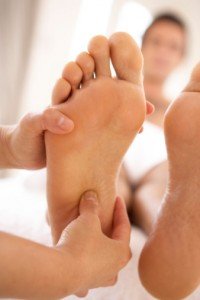Have you got Plantar Fasciitis?
You get out of bed in the morning and the first few steps cause a sharp pain. Be careful! You may have plantar fasciitis. It’s an overuse injury that affects the sole of the foot.
It often starts gradually and only as mild pain. And bizarrely, you’re more likely to feel it after exercise rather than during exercise. But if you do get that pain first thing in the morning, or after a period of sitting down, the alarm bells should start ringing.
So what is Plantar Fasciitis? And what measures should you take to look after yourself?

What is Plantar Fasciitis?
Understanding Plantar Fasciitis
Imagine pressing your foot down on the accelerator or brake of your car. The technical name for this movement is plantar flexion. It involves your calf muscles but also the muscles in the bottom of your feet. Plantar fasciitis is a condition that affects theses muscles in the bottom of the feet.
Obviously your feet have to work very hard. They take your full body weight, and when you run, the forces that are exerted through the feet are intensified. To help protect you from these forces there is a specific band of tissue that supports the arch of your foot. It’s known as the plantar fascia, and it’s a ligament that connects your heel bone to your toes.
Unfortunately however, if the fascia is overworked it can become inflamed. This condition is known as plantar fasciitis. Certain factors will put you at a higher risk of suffering the condition. These include being overweight, spending a lot of time walking or running on hard surfaces, having high or low heel arches, and having tight or inflexible calf muscles.
How to deal with Plantar Fasciitis
As with most injuries start with complete rest. In the early stages remember to regularly ice the heel. But as it is such a common injury there are a number of other potential solutions to the problem as well.
One of the most ingenious is the plantar fasciitis night splint. The idea of the splint is simply to keep your fascia ligament stretched while you sleep. This works by keeping the ankle bent throughout the night.
Many people have found that by wearing a splint it can help them walk more easily in the mornings. They start to notice less pain in the following weeks. But although the night splint can be very effective, many people find them inconvenient to use.
As I alluded to earlier, tight calf muscles often compound the problem of plantar fasciitis. To counter this regular calf stretching can help. Be sure to include a bent knee calf stretch as well as a straight knee calf stretch to make sure that both calf muscles are stretched thoroughly.
If you are still training, try putting an arch in your training shoe. This helps to take some of the stress off the fascia. This is particularly useful if you have a low arch in the foot.
And finally, don’t forget to book in for a massage. This can not only help with the immediately affected area, but can help to redress associated muscle imbalances as well, and will help guard against further injury.
We hope this information is useful for you. If you have any questions about our treatments, please contact us. You can find us in Mill Hill Broadway and Islington. If you like this blog, please share!
We are always happy to help.



